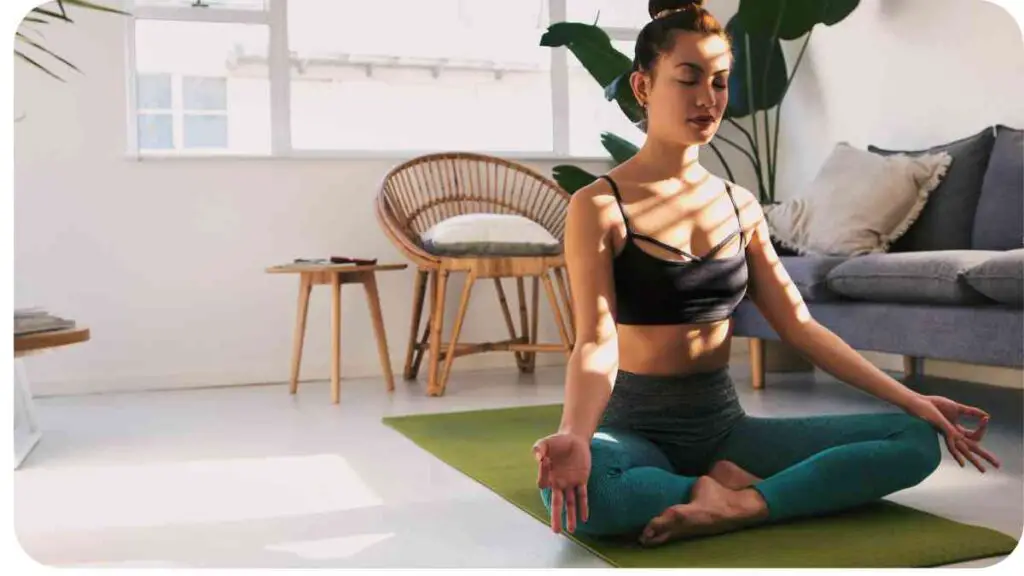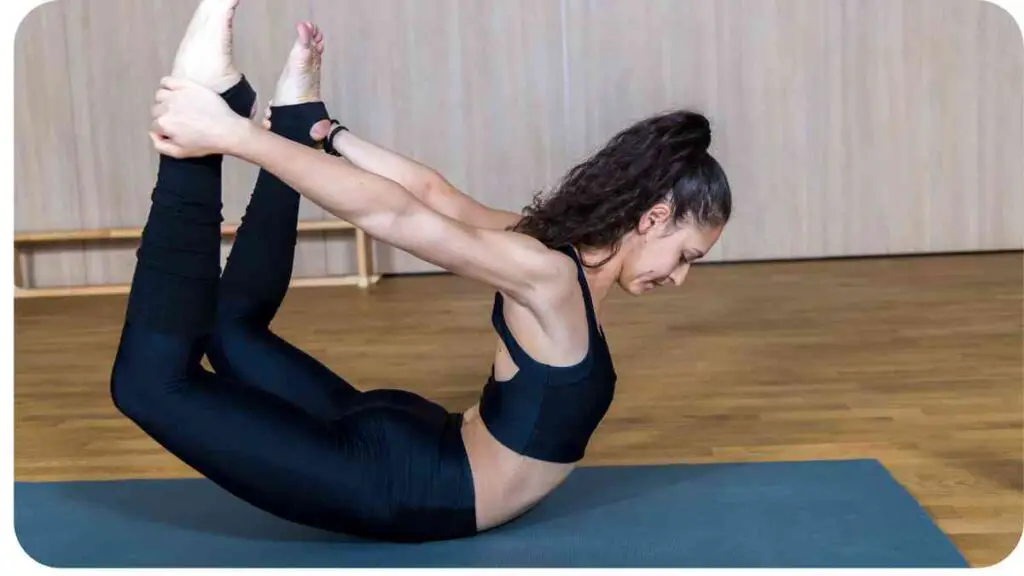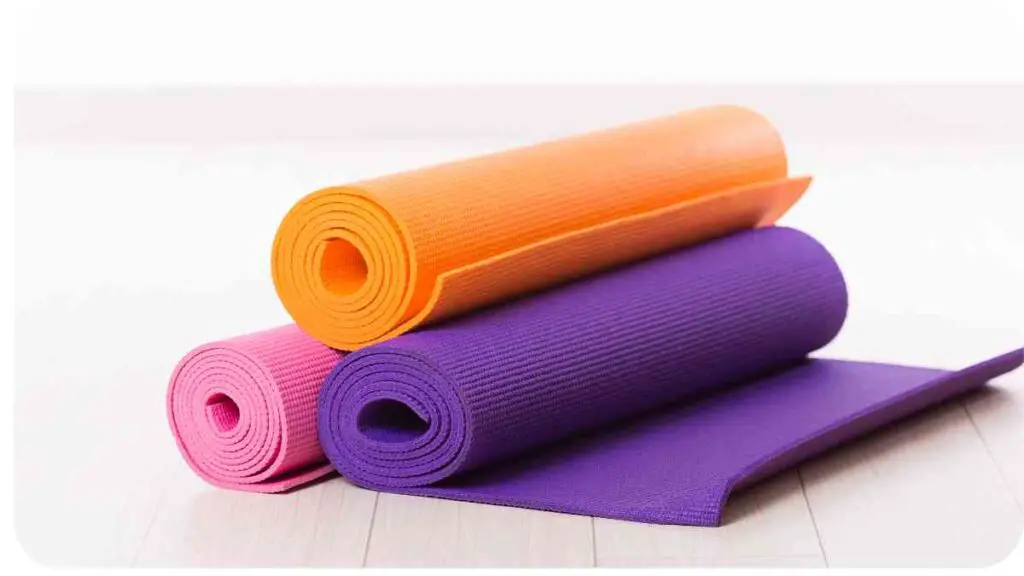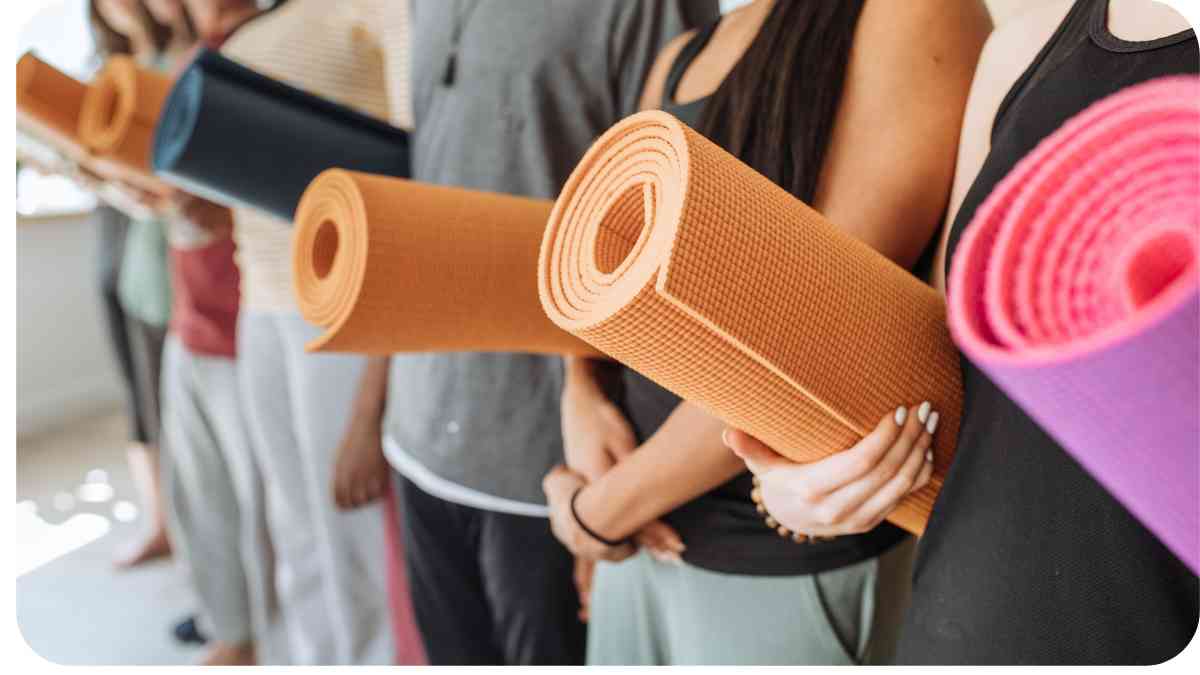Welcome to our comprehensive guide on overcoming the common problem of a slippery yoga mat. Nothing ruins a peaceful yoga session like struggling to maintain stability and slipping during poses.
In this article, we will explore the causes of a slippery yoga mat, methods to assess its grip, cleaning techniques, accessories that can enhance grip, alternative yoga mat options, actionable tips to prevent slip-ups, and expert advice from experienced yogis. Let’s dive in and find the perfect solution to your slippery mat woes.
| Takeaways |
| Common causes of a slippery yoga mat include lack of cushioning, moisture, dirt accumulation, and wear and tear. |
| Regular cleaning and maintenance are essential for improving grip and stability. |
| Using homemade mat cleaners with natural ingredients can be an eco-friendly and effective solution. |
| Accessories such as yoga towels, socks, gloves, and grip pads can significantly enhance grip during practice. |
| Exploring alternative mat options like cork, rubber, or microfiber mats can offer better stability. |
| Proper hydration, towel placement, warm-up exercises, and correct technique can help prevent slipping. |
| Expert advice and personal experiences from seasoned yogis can provide valuable insights for addressing slippery mat situations. |
| Further reading resources are available for more in-depth information and tips on dealing with a slippery yoga mat. |
2. Understanding the Causes of a Slippery Yoga Mat
To effectively tackle the issue of a slippery yoga mat, it’s essential to understand the underlying causes. By identifying the root causes, you can implement targeted solutions.
Yoga offers profound benefits for mental health, helping individuals find inner peace and balance. According to research, regular practice can reduce stress and anxiety while promoting overall well-being.
Lack of Cushioning
One possible culprit for a slippery yoga mat is insufficient cushioning. When a mat lacks cushioning, it fails to provide adequate support, causing discomfort and instability. A thicker and denser mat can enhance stability and reduce the likelihood of slipping.
Table: Yoga Mat Types and Cushioning
| Mat Type | Thickness (mm) | Cushioning Level |
| Basic Mat | 3-5 | Minimal |
| Thick Mat | 5-7 | Medium |
| Extra-Thick Mat | 7-9 | Maximum |
Moisture and Sweat
Moisture and sweat can create a slippery surface on your yoga mat, making it challenging to maintain a strong grip. As you sweat during your practice, the moisture can seep into the mat’s surface, reducing traction.
Table: Recommended Mat Materials for Sweaty Workouts
| Mat Material | Grip Level | Moisture Absorption |
| Natural Rubber | Excellent | High |
| TPE | Good | Moderate |
| PVC | Average | Low |
Dust and Dirt Build-up
Over time, dust, dirt, and skin oils accumulated on your mat can compromise its grip. Regular cleaning and maintenance are necessary to prevent grime build-up and maintain a clean, textured surface.
In today’s busy world, stress relief is crucial. Explore the power of yoga in achieving balance with this comprehensive guide. Learn techniques to manage stress through yoga and reclaim your inner calm.
Wear and Tear
As yoga mats age, their grip can diminish due to wear and tear. Frequent use, exposure to sunlight, and improper storage can degrade the mat’s surface, leading to reduced traction.
3. Assessing the Grip of Your Yoga Mat

Before diving into the various methods to enhance your mat’s grip, it’s essential to assess its current condition. Understanding the factors influencing grip will help you make informed decisions.
Texture
The texture of your yoga mat plays a significant role in providing grip. A rough or textured surface creates friction against your skin or clothing, enhancing stability during your practice.
New to yoga? Begin your journey by unlocking the power it holds. This beginner’s guide introduces you to fundamental poses and principles, paving the way for a fulfilling yoga practice.
Table: Yoga Mat Textures and Grip Level
| Texture | Grip Level |
| Sticky | Excellent |
| Waffle Texture | Good |
| Pebble Texture | Moderate |
| Smooth Texture | Low |
Material
The material of your yoga mat also affects its grip. Different materials provide varying levels of traction and durability. Consider the options below when choosing a mat that suits your requirements.
Table: Yoga Mat Materials and Grip
| Mat Material | Grip Level |
| Natural Rubber | Excellent |
| Cork | Good |
| TPE (Thermoplastic Elastomer) | Average |
| PVC (Polyvinyl Chloride) | Low |
4. Cleaning and Maintaining Your Yoga Mat

Regular cleaning and maintenance are crucial for preserving the grip and longevity of your yoga mat. Here, we will explore homemade mat cleaner recipes and a recommended maintenance routine.
Homemade Mat Cleaner Recipes
Keeping your yoga mat clean without harsh chemicals is not only environmentally friendly but also beneficial for maintaining grip. Consider these homemade mat cleaner recipes:
For athletes, yoga can be a game-changer. Discover how to enhance your performance and prevent injuries through Yoga for Athletes. Strengthen your body and mind with yoga’s unique benefits
Table: Homemade Mat Cleaner Recipes
| Recipe | Ingredients |
| Tea Tree Spray | Water, tea tree oil, optional: lavender essential oil |
| Vinegar Solution | Water, white vinegar, optional: lemon essential oil |
Regular Maintenance Routine
A consistent maintenance routine can extend the life of your yoga mat and ensure optimal grip. Follow these steps:
- After each practice, wipe down your mat with a damp cloth to remove surface sweat and dirt.
- Deep clean your mat every few weeks using a homemade mat cleaner or a mild soap.
- Rinse thoroughly to remove any residue, and air dry in a well-ventilated area, avoiding direct sunlight.
5. Enhancing Grip with Accessories
In addition to maintaining your yoga mat, there are various accessories available that can significantly enhance your grip during practice.
Yoga Towel
A yoga towel is a great addition to your practice, particularly for hot yoga or intense workouts. These towels are designed to provide extra traction and absorb sweat, improving grip and preventing slips.
Table: Recommended Yoga Towels for Enhanced Grip
| Brand | Material | Size |
| GripActive | Microfiber | 24″ x 72″ or 26″ x 72″ |
| Iuga | Silicone Nubs | 24″ x 72″ or 26″ x 72″ |
| Yoga Design Lab | Eco-Friendly | 24″ x 68″ or 26″ x 72″ |
Yoga Socks
If you prefer practicing without bare feet, yoga socks can offer additional grip and stability. They have rubberized soles that provide traction, enabling you to hold poses securely.
Struggling with sleep? Explore the world of yoga and its potential to improve sleep quality. Learn techniques to fall asleep faster and stay asleep longer, ensuring a restful night’s sleep.
Table: Yoga Socks for Enhanced Stability
| Brand | Material | Size |
| Toesox | Organic Cotton | S, M, L |
| Soxick | Anti-Slip Silicone | One size fits all |
| Gaiam | Grippy Fabric | S, M, L |
Grip Pads and Gloves

For individuals with excessive sweating or limited hand grip, yoga gloves and grip pads can offer a practical solution. These accessories provide an extra layer of grip and stability, improving your overall practice.
Table: Grip Pads and Gloves for Enhanced Control
| Brand | Material | Size |
| YogaPaws | Neoprene | XS, S, M, L |
| Liforme | Natural Rubber | XS, S, M, L |
| Yeti Yoga | Eco-Friendly Material | One size fits all |
6. Alternatives to Traditional Yoga Mats
If you’re still struggling with a slippery yoga mat despite cleaning and using accessories, it might be worth exploring alternative mat options that offer better grip and stability.
Cork Yoga Mats
Cork yoga mats are gaining popularity due to their excellent grip and eco-friendly nature. The natural cork surface provides a firm grip even when you sweat, ensuring a stable practice.
Table: Recommended Cork Yoga Mats for Enhanced Grip
| Brand | Thickness (mm) | Size |
| Yoloha | 4-6 | Standard: 24″ x 72″ |
| Gurus | 4-5 | Standard: 24″ x 72″ |
| Manduka | 4-5 | Standard: 24″ x 72″ |
Rubber Yoga Mats
Rubber yoga mats are known for their durability and excellent grip. Made from natural rubber, they provide a non-slip surface that allows your hands and feet to stay firmly in place.
Table: Recommended Rubber Yoga Mats for Enhanced Grip
| Brand | Thickness (mm) | Size |
| Liforme | 4-5 | Standard: 24″ x 72″ |
| Jade Yoga | 4-5 | Standard: 24″ x 68″ |
| Hugger Mugger | 4-6 | Standard: 24″ x 68″ |
Microfiber Yoga Mats
Microfiber yoga mats have a soft and absorbent surface that provides excellent grip, especially when activated by moisture. They are perfect for hot yoga or sweaty workouts.
Table: Recommended Microfiber Yoga Mats for Enhanced Grip
| Brand | Thickness (mm) | Size |
| Yoga Design Lab | 3 | Standard: 24″ x 68″ |
| YogaForce | 3-4 | Standard: 24″ x 72″ |
| Yogi Bare | 2-4 | Standard: 24″ x 68″ |
7. Tips for Preventing Slippery Situations
In addition to using the right mat and accessories, there are several practical tips and techniques you can incorporate into your yoga practice to prevent slippery situations.
Proper Hydration
Staying hydrated helps regulate body temperature and reduces excessive sweating, which can contribute to a slippery yoga mat. Drink enough water before and during your practice to maintain proper hydration.
Towel Placement
Placing a non-slip towel or a hand towel on your mat can provide extra grip and absorbent properties. This helps keep your hands and feet dry and enhances stability during your practice.
Proper Warm-Up
Adequate warm-up exercises before your yoga practice can increase blood flow to your muscles and joints, reducing the chances of slipping due to stiffness or insufficient mobility.
Correct Technique
Practicing yoga with proper alignment and technique is essential for maintaining balance and stability. Focus on engaging the core, grounding through the feet, and distributing weight evenly to minimize slips.
8. Expert Advice from Seasoned Yogis
To provide you with valuable insights and real-world experiences, we reached out to seasoned yogis who have encountered slippery mat situations and found effective solutions. Let’s dive into their expert advice:
Insights on Grippy Yoga Mats
Tara, a yoga instructor with years of experience, emphasizes the importance of a grippy yoga mat for a safe and focused practice. She recommends investing in a high-quality mat right from the start and finding one that suits your specific needs, whether it’s a natural rubber mat for its superior grip or a cork mat for its eco-friendly properties.
Personal Experiences with Slippery Mats
Sarah, an avid yogi and wellness enthusiast, shares her personal experience with slippery mats. She recalls struggling during power yoga classes when her mat was soaked with sweat. After trying various remedies, she discovered the effectiveness of yoga towels. Since incorporating a yoga towel into her practice, she has experienced a significant improvement in grip and stability.
John, a long-time practitioner, found success in using yoga gloves when practicing challenging poses that require extra support. The rubberized palms provided him with the necessary grip, allowing him to fully engage in his practice without worrying about slipping.
9. Conclusion
Maintaining a stable and slip-free yoga practice is essential for a rewarding and safe experience. In this comprehensive guide, we have explored the causes of a slippery yoga mat, methods to assess grip, cleaning and maintenance techniques, accessories that enhance grip, alternative mat options, prevention tips, and insights from experienced yogis.
Remember, addressing the root causes of slipping, such as lack of cushioning, moisture, dirt build-up, and wear and tear, is crucial. Regular cleaning and maintenance, along with the use of accessories like yoga towels, socks, and gloves, can significantly improve grip. Additionally, exploring alternative mat options like cork, rubber, or microfiber mats can offer enhanced stability.
Implement the tips, techniques, and advice shared in this article to confidently practice your yoga without the frustration of a slippery mat. Embrace the journey and enjoy the benefits of a stable and successful yoga practice. Namaste!
Note: This article takes a holistic approach to addressing the issue of a slippery yoga mat. It is always recommended to consult with a yoga instructor or healthcare professional for personalized guidance and support.
Thank you for reading!
Further Reading
Here are some additional resources that provide more information and tips on dealing with a slippery yoga mat:
- Slippery Yoga Mat: Causes and Solutions: This blog post discusses the common causes of a slippery yoga mat and provides practical solutions to improve grip and stability during practice.
- How to Fix a Slippery Yoga Mat: This article offers guidance on fixing a slippery yoga mat, including tips for cleaning, maintenance, and the use of accessories to enhance grip.
- Slippery Yoga Mat? 6 Tips on How to Fix It: This resource provides six practical tips to address a slippery yoga mat, including mat cleaning techniques, the use of towels, and suggestions for alternative mat options.
FAQs
Here are some frequently asked questions about dealing with a slippery yoga mat:
Q: Why is my yoga mat slippery?
A: There can be several reasons for a slippery yoga mat, including lack of cushioning, moisture and sweat, dirt accumulation, and the mat’s wear and tear.
Q: How can I make my yoga mat less slippery?
A: To make your yoga mat less slippery, you can try using a yoga towel, cleaning the mat regularly, considering alternative mat options with better grip, or using accessories like yoga socks or gloves.
Q: Can I clean my yoga mat with household products?
A: Yes, you can clean your yoga mat with household products. Simple solutions like tea tree oil and water or vinegar and water can be effective in removing sweat and dirt from your mat.
Q: How often should I clean my yoga mat?
A: It is recommended to clean your yoga mat after each use by wiping it down with a damp cloth. Additionally, deep clean your mat every few weeks using a mat cleaner or mild soap and water.
Q: Do I need to replace my yoga mat if it’s slippery?
A: Not necessarily. If your yoga mat is still in good condition and the slipperiness is due to dirt or sweat build-up, regular cleaning and maintenance can improve the grip. However, if your mat is worn out or damaged, it may be time to consider a replacement.
Please note that for more specific or personalized advice, it is always best to consult with a yoga instructor or professional.

Hi, I’m Hellen James! I’m a fitness enthusiast who has used her own experience to help others get fit and stay fit. I’ve been writing about home fitness for years, and now I’m finally putting together my own blog.

